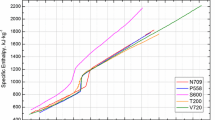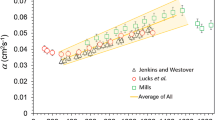Abstract
Numerical simulation of vacuum arc re-melting, pressurized or protective electro-slag re-melting, and ingot casting have become quite important in the metal industry. However, a major drawback of these simulation techniques is the lack of accurate thermophysical properties for temperatures above 1,500 K. Heat capacity, heat of fusion, density, and thermal conductivity are important input parameters for the heat transfer equation. Since, direct measurements of thermal conductivity of alloys in the liquid state are almost impossible, its estimation from electrical conductivity using the Wiedemann–Franz law is very useful. The afore-mentioned thermophysical properties of several steels are investigated within the context of an ongoing project. Here, we present a full set of thermophysical data for the chromium–nickel–molybdenum steel meeting the standard DIN 1.4435 (X2CrNiMo18-14-3); these values will be used by our partner to simulate various re-melting and solidification processes. Wire-shaped samples of the steel are resistively volume-heated, as part of a fast capacitor discharge circuit. Time-resolved measurements with sub-μs resolution of current through the specimen are performed with a Pearson probe. The voltage drop across the specimen is measured with knife-edge contacts and ohmic voltage dividers, the temperature of the sample with a pyrometer, and the volumetric expansion of the wire with a fast acting CCD camera. These measurements enable the heat of fusion, the heat capacity, and the electrical resistivity to be determined as a function of temperature in the solid and liquid phases. The thermal conductivity and thermal diffusivity are estimated via the Wiedemann–Franz law.
Similar content being viewed by others
References
Wilthan B., Cagran C., Pottlacher G. (2005) Int. J. Thermophys. 26:1017
Otter C., Pottlacher G., Jäger H. (1996) Int. J. Thermophys. 17:987
K. Mills, Recommended Values of Thermophysical Properties for Selected Commercial Alloys (ASM Int., Materials Park, Ohio, 2002), ISBN: 0-87170-753-5
T.K. Chu, C.Y. Ho, in Proceedings of the 15th International Conference on Thermal Conductivity, Ottawa, Canada (Plenum Press, New York, 1978), pp. 79–104
R.D. Pehlke, A. Jeyarajan, H. Wada, Summary of Thermal Properties for Casting Alloys and Mold Materials (University of Michigan, National Technical Information Service (STI), 1982)
Klemens P.G., Williams R.K. (1986) Int. Metals Rev. 31:197
Wilthan B., Cagran C., Brunner C., Pottlacher G. (2004) Thermochim. Acta 415:47
Deutsches Institut für Normung e.V. DIN. Leitfaden zur Angabe der Unsicherheit beim Messen. Beuth Verlag GmbH, 1st edn., 1995; original: Guide to the Expression of Uncertainty in Measurement (ISO, Geneva, Switzerland, 1993)
M. Matus, Technisches Messen 72, 584 (2005), ISSN: 0171-8096
Author information
Authors and Affiliations
Corresponding author
Rights and permissions
About this article
Cite this article
Wilthan, B., Reschab, H., Tanzer, R. et al. Thermophysical Properties of a Chromium–Nickel–Molybdenum Steel in the Solid and Liquid Phases. Int J Thermophys 29, 434–444 (2008). https://doi.org/10.1007/s10765-007-0300-1
Published:
Issue Date:
DOI: https://doi.org/10.1007/s10765-007-0300-1




